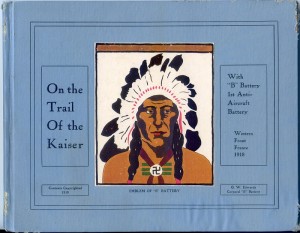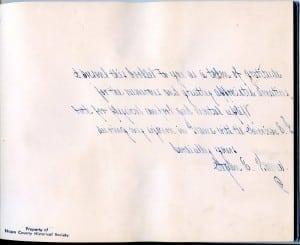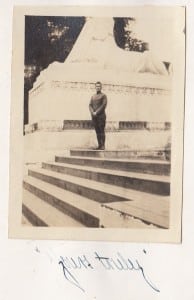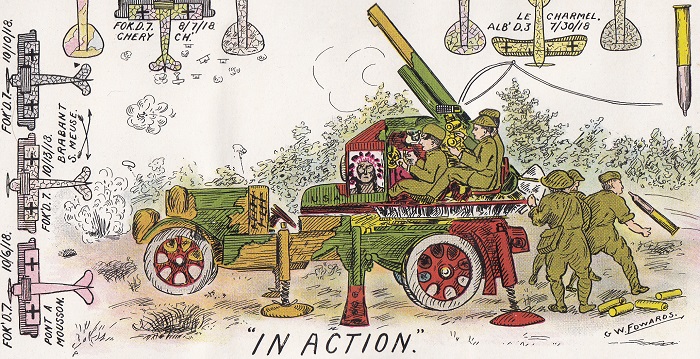Found It In The Archives, People
The Battery “B” Mystery
by Marie Bowen, NCHS volunteer
 A small book with photographs pasted on the blank pages entitled On the Trail of the Kaiser was found recently among NCHS’s collections. The item had no donor or accession number and was a complete mystery. I was asked to find, if possible, a link to Napa County that might explain why NCHS had received the book. It was published in 1919 by Corporal G. W. Edwards of “B” Battery, 1st Anti-Aircraft Battery (Western Front, France 1918). The text begins with the formation of “B” Battery at Fort Miley, San Francisco, in November 1917, noting that a percentage of the personnel were Coast Artillery troops from the California National Guard. On December 8, 1917, the battalion reached New Jersey, then onto New York, and then to France December 14 on the U.S.N. Susquehannah.
A small book with photographs pasted on the blank pages entitled On the Trail of the Kaiser was found recently among NCHS’s collections. The item had no donor or accession number and was a complete mystery. I was asked to find, if possible, a link to Napa County that might explain why NCHS had received the book. It was published in 1919 by Corporal G. W. Edwards of “B” Battery, 1st Anti-Aircraft Battery (Western Front, France 1918). The text begins with the formation of “B” Battery at Fort Miley, San Francisco, in November 1917, noting that a percentage of the personnel were Coast Artillery troops from the California National Guard. On December 8, 1917, the battalion reached New Jersey, then onto New York, and then to France December 14 on the U.S.N. Susquehannah.
 In the inside cover of the book is written the Oakland address for L. E. Bowen. On the facing page, in spectacular backhand, is an inscription of presentation without direct reference to L. E. Bowen. It is signed by Stephen E. Wagner, presenting the booklet in gratitude for…“numerous and greatly appreciated donations…during my sojourn in France with the American Expeditionary Force.” Near the back of the book, the “B” Battery roster includes “Corporal Wagner” and “Corporal Edwards” as two of the 73 surviving personnel, and so I began my research assuming the inscriber and the author were, respectively, Corporals Wagner and Edwards.
In the inside cover of the book is written the Oakland address for L. E. Bowen. On the facing page, in spectacular backhand, is an inscription of presentation without direct reference to L. E. Bowen. It is signed by Stephen E. Wagner, presenting the booklet in gratitude for…“numerous and greatly appreciated donations…during my sojourn in France with the American Expeditionary Force.” Near the back of the book, the “B” Battery roster includes “Corporal Wagner” and “Corporal Edwards” as two of the 73 surviving personnel, and so I began my research assuming the inscriber and the author were, respectively, Corporals Wagner and Edwards.
An unusual feature of the book is its annotated photos either of or taken by Wagner while in France. This led me first to think he must have known L. E. Bowen. Ancestry.com provided Alameda County address directories for L. E. (aka Lottie or Charlotte) Bowen at the Oakland address noted in the front of the book. Lottie was a clerk, unmarried, and living with her elderly mother until her (Lottie’s) death at age 59 in 1933. At that point, I surmised she and possibly others had received the book after a donation of some sort to the troops in France. She seemed totally unconnected to Napa County and very likely unconnected to Stephen Wagner, despite the numerous personal photographs.
Thinking Wagner may have joined “B” Battery at Fort Miley, I searched California records but had no success. Equally unproductive were websites for “B” Battery. But at Ancestry.com’s U.S., Headstone Applications for Military Veterans, 1925-1963, I found Corporal Stephen Edward Wagner, born July 1, 1889, Detroit, Michigan, serving with the 2nd Co. Coast Defense, Eastern New York – CAC, 1914-1920. Although the record did not mention ‘B’ Battery, I felt this was Stephen and that he had joined the battalion when it arrived in New York.
 Then, in U.S. Army, Register of Enlistments, 1798-1914, I learned Stephen already had served “along the Mexican border,” from 1911-1914. He seemed to be a career military man. By the 1920 census, he was a soldier in Queens, New York; later immigration records show him returning twice from the Panama Canal Zone in the early 1930s. He died in Pinellas, Florida, February 18, 1961. His burial records at Bay Pines National Cemetery state: “Corporal, US Army; Mexican Border; World War 1.” I felt this was the Stephen Wagner who inscribed our book, although I never found evidence of his distinctive signature.
Then, in U.S. Army, Register of Enlistments, 1798-1914, I learned Stephen already had served “along the Mexican border,” from 1911-1914. He seemed to be a career military man. By the 1920 census, he was a soldier in Queens, New York; later immigration records show him returning twice from the Panama Canal Zone in the early 1930s. He died in Pinellas, Florida, February 18, 1961. His burial records at Bay Pines National Cemetery state: “Corporal, US Army; Mexican Border; World War 1.” I felt this was the Stephen Wagner who inscribed our book, although I never found evidence of his distinctive signature.
But why did NCHS have the book? With some embarrassment, I realized I had not “searched the laterals.” In other words, what if Lottie’s family rather than Lottie herself had a connection to Napa? She died unmarried and seemingly without children so it was possible her possessions may have passed to other relatives.
In Ancestry.com’s public family tree collections, I found entries for Lottie and her several siblings. And there was the connection I was looking for. Lottie’s sister Daisy had married Warren Steves, son of John Henry Steves, founder of Steves Hardware in St. Helena. It remains unknown when the book arrived at NCHS but it seems very possible it was included with other Steves family donations.


